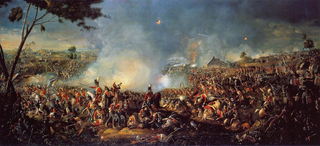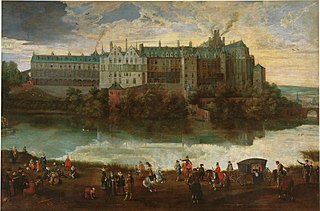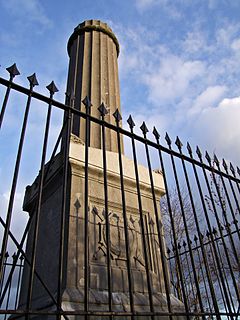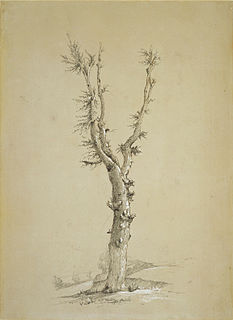
The Battle of Waterloo was fought on Sunday 18 June 1815, near Waterloo. A French army under the command of Napoleon was defeated by two of the armies of the Seventh Coalition. One of these was a British-led coalition consisting of units from the United Kingdom, the Netherlands, Hanover, Brunswick, and Nassau, under the command of the Duke of Wellington. The other was composed of three corps of the Prussian army under the command of Field Marshal von Blücher. The battle marked the end of the Napoleonic Wars. The battle was contemporaneously known as the Battle of Mont Saint-Jean (France) or La Belle Alliance.

Arthur Wellesley, 1st Duke of Wellington, was an Anglo-Irish soldier and Tory statesman who was one of the leading military and political figures of 19th-century Britain, serving twice as prime minister of the United Kingdom. He is among the commanders who won and ended the Napoleonic Wars when the coalition defeated Napoleon at the Battle of Waterloo in 1815.

Duke of Wellington is a title in the Peerage of the United Kingdom. The name derived from Wellington in Somerset. The title was created in 1814 for Arthur Wellesley, 1st Marquess of Wellington, the Anglo-Irish military commander who is best known for leading the decisive victory with Field Marshal von Blücher over Napoleon's forces at Waterloo in Brabant. Wellesley later served twice as British prime minister.

Apsley House is the London townhouse of the Dukes of Wellington. It stands alone at Hyde Park Corner, on the south-east corner of Hyde Park, facing south towards the busy traffic roundabout in the centre of which stands the Wellington Arch. It is a Grade I listed building.

La Belle Alliance is an inn situated a few miles south of Brussels in Belgium, chiefly remembered for its significance in the aftermath of the Battle of Waterloo.

The Waterloo campaign was fought between the French Army of the North and two Seventh Coalition armies, an Anglo-allied army and a Prussian army. Initially the French army was commanded by Napoleon Bonaparte, but he left for Paris after the French defeat at the Battle of Waterloo. Command then rested on Marshals Soult and Grouchy, who were in turn replaced by Marshal Davout, who took command at the request of the French Provisional Government. The Anglo-allied army was commanded by the Duke of Wellington and the Prussian army by Prince Blücher.

The Palace of Coudenberg was a royal residence situated on the Coudenberg or Koudenberg, a small hill in what is today the Royal Quarter of Brussels, Belgium.

The Lion's Mound is a large conical artificial hill located in Wallonia in the municipality of Braine-l'Alleud, Belgium. King William I of the Netherlands ordered its construction in 1820, and it was completed in 1826. It commemorates the location on the battlefield of Waterloo where a musket ball hit the shoulder of William II of the Netherlands and knocked him from his horse during the battle. It is also a memorial of the Battle of Quatre Bras, which had been fought two days earlier, on 16 June 1815.

Colonel Sir William Howe De Lancey was an officer in the British Army during the Napoleonic Wars. He died of wounds he received at the Battle of Waterloo.

The Duchess of Richmond's ball was a ball hosted by Charlotte, Duchess of Richmond in Brussels on 15 June 1815, the night before the Battle of Quatre Bras. Charlotte's husband Charles Lennox, 4th Duke of Richmond, was in command of a reserve force in Brussels, which was protecting that city in case Napoleon Bonaparte invaded.
James Graham (1791–1845) was an Irish non-commissioned officer (NCO) in the British Army during the Napoleonic Wars, recognised as the "bravest man in the army". Serving in the Coldstream Guards, he was commended for his gallantry during the defence of Hougoumont, at Waterloo. Graham saved the life of an officer, and his own brother, and was among the small group responsible for closing the North Gate at Hougoumont after a French attack – an act which won the Duke of Wellington's encomium. He was rewarded with a specially cast gallantry medal and an annuity. After later serving in the 12th Royal Lancers, Graham was discharged in 1830 for ill health, and died at the Royal Hospital Kilmainham in 1845.
William Siborne, Sibourne or Siborn was a British officer and military historian whose most notable work was a history of the Waterloo Campaign.

Lieutenant-Colonel Sir Alexander Gordon was a Scottish officer in the British Army who was killed at the Battle of Waterloo. His correspondence was collated and published early in the early 21st century.
Pierre-François Flaugergues (1767–1836) was a French lawyer who took an active part in national politics between January 1813 and September 1816.
Sir William Douglas of Balgillo K.C.B., was a British Army officer during the Napoleonic Wars.
Treasure Houses of Britain is a 1985 documentary television series, narrated by John Julius Norwich and showcasing a number of country houses in Great Britain, produced for American television in concert with an art exhibition touring the United States at the same time.

The Waterloo Elm was located just south west of the intersection of the sunken lane and the Genappe–Brussels main road. It was the Duke of Wellington's command post for much of the Battle of Waterloo. The tree was killed by souvenir hunters after the battle. It was felled in 1818 and made into furniture, including a chair, made by Thomas Chippendale, the younger, that was presented to George IV and remains in the British Royal Collection.

Napoleon's Last HQ is a museum housed in the Ferme du Caillou at Genappe, Belgium, in which the Emperor Napoleon stayed the night before the Battle of Waterloo on 18 June 1815. The site is located 4 kilometres (2.5 mi) south of the Lion of Waterloo, at Chaussée de Bruxelles 66, 1472 Genappe. Travelling north, the high road passes pass over the Waterloo battlefield through Waterloo and on to Brussels.
This is a list of the etymology of street names in the London district of Waterloo. The area has no formally defined boundaries – those utilised here are the river Thames to the north and west, Blackfriars Road to the east, and Westminster Bridge Road to the south.





















